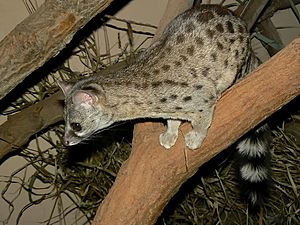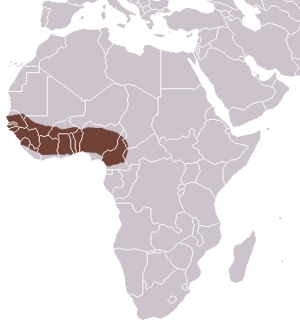Hausa genet facts for kids
Quick facts for kids Hausa genet |
|
|---|---|
 |
|
| Conservation status | |
| Scientific classification | |
| Genus: |
Genetta
|
| Species: |
thierryi
|
 |
|
| Hausa genet range | |
The Hausa genet (Genetta thierryi) is a small, cat-like animal. It lives in the savannas of West Africa. Scientists say it is a species of genet. The IUCN Red List says it is a species of "Least Concern." This means it is not currently in danger of disappearing.
You can find Hausa genets in different places. They live in Senegal's wooded areas. They also live in moist forests in Guinea-Bissau. And they are found in rainforests in Sierra Leone, Ghana, and Ivory Coast.
Contents
What Does the Hausa Genet Look Like?
The Hausa genet has fur that is bright and short. It has a brown-reddish line along its back. This line is crossed by a brighter colored stripe. Its feet are light, matching the color of the ground.
Fur Patterns and Tail
The genet's tail has dark and light rings. It also has a black tip. Its body has two rows of long spots on its back. The spots on its shoulders, thighs, and sides are smaller and darker. Its front and back legs do not have spots.
How Habitat Affects Appearance
The Hausa genet's fur can change. It depends on where it lives. In savanna areas, its fur is shorter and paler. In forest areas, its fur is longer and more yellow. This helps it blend into its surroundings.
Where Do Hausa Genets Live?
The Hausa genet lives in several West African countries. These include Gambia, Guinea-Bissau, and Cameroon. They prefer moist and dry savannas. These areas often have open woodlands.
Different Habitats
They have also been seen in dry, wooded areas in Senegal. Sometimes, they are found in rainforests. These rainforests are in Sierra Leone, Ghana, and Côte d’Ivoire. This shows they can adapt to different environments.
Hausa Genet Behavior and Lifestyle
Not much is known about the daily life of the Hausa genet. Scientists are still studying them. They think its hunting habits are like other genets. Its diet probably includes small animals and insects.
Where They Live and Reproduce
Their breeding habits are also a bit of a mystery. It is thought that these genets make their homes in rocky areas. They might also dig holes in the ground. One young genet was found sleeping in a hollow tree. Two half-grown genets were found in Mali in November. This suggests that baby genets might be born between January and March.
Threats to Hausa Genets
Hausa genets face some dangers. In certain areas, people hunt them. Sometimes, they are seen for sale as food. However, scientists do not know how much this hunting affects their numbers. They are still listed as "Least Concern."


